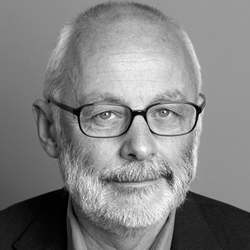
Caution overhead fibre
Generally terrestrial base stations each cover a cell and the cells overlap to provide (hopefully) seamless coverage of the target area. The target might be set as a proportion of the total land area, but that usually includes places with challenging topography and few users which are very expensive to cover. So the target is more often a high proportion of population.
Cells get deployed with varying sizes depending on the population density and the maximum range of the radio technology. In dense urban areas cell radius may be 500m or smaller for high capacity; in rural areas 5km or more for minimum cost per user. In towns the higher frequencies, up to 4.2GHz, can be used; but in rural areas 1800MHz or lower, down to 600 MHz, supports larger cells. Coverage planning uses sophisticated graphical information systems and propagation models but despite the science behind the approach many users complain about “not-spots” in supposedly-covered rural and urban areas.
Increasing user data rate everywhere leads to pressure on low- and mid-band spectrum. One approach could be to make rural cells smaller so they can re-use the low frequencies; or smaller still and use high band. More cells need more sites and more backhaul which increases network costs geometrically, and the low user density means that there may be not enough revenue to justify the investment. Looking ahead to 6G one objective should be to fix the coverage problem properly so everyone gets service all the time wherever they are. That would need more spectrum at lower frequencies to be economic, but the spectrum warehouse is empty.
Perhaps we are starting from the wrong end of the problem? If one focuses on where the users actually are, in those areas that are expensive to cover they are, most of the time, highly localised. They are at home, or travelling (walking/cycling/driving) along roads. If the users are “things” rather than people, by and large the bandwidth needs are significantly smaller though things can have a wider distribution (think: crop humidity sensors), so existing infra may already provide coverage1.

In many rural areas there is already a lot of communications infrastructure. Looking at the UK specifically2, in 2017/18 85% of households had a landline telephone, a decline from 95% in 20003.
In 2021, 97% of UK households had Internet access, of which a high proportion would be via a fixed broadband connection. So there is a fixed telecoms connection to a very high proportion of premises. An increasing proportion of these connections – 21% in 2021 according to Ofcom – use Fibre To The Premises (FTTP), and this is increasing rapidly even in rural areas.
|
CW JOURNAL ARTICLES STRAIGHT TO YOUR INBOX Subscribe now |
Deployed FTTP systems can support 1 Gbit/s. Where the final connection is not by fibre a high proportion of systems use fibre to the cabinet. Small yellow plastic labels (see header image above) are becoming a familiar sight on telephone poles throughout the country.
These statistics are given not because the wireless focus should be on homes especially but because they show that local communications infrastructure is all-pervasive throughout the landmass, and much of it will bring fibre right to the “edge” in the near future. On its way to the premises the fibre cables run mainly along roads. Usually there is power nearby, but even if not renewable energy can harvested using solar panels which are a common sight on traffic warning signs, with lithium batteries for storage.

This suggests an alternative approach to rural coverage. Use very small cells, with FTTP backhaul and possibly radio over fibre. Transmit power would be low. Base station equipment – essentially picocells – would be mounted on existing telecom or lighting poles; though sometimes new poles might be needed. The physical layer would no longer have to support long range operation and techniques such as cell-free. Massive MIMO could come into their own. Pressure on the low frequency bands could be much reduced and these perhaps be used mainly for supporting lower data rate “things” communications to more distributed devices.
The circuitry needed in the terminal could be much simpler when the radio looks much more like a Wi-Fi device than today’s multi-band FDD CA MIMO modems. Total radiated power levels from both handsets and infra could be much lower. The network coverage map could essentially start to look like a road map, with long corridors of high bandwidth coverage along all highways that have telecoms infrastructure along them, also covering maybe a couple of hundred meters each side. This would be overlaid on the existing “thin” coverage to pick up the small number of users who are actually not on the highways or in adjacent buildings. Interestingly, radio network planning would be much more like fixed network planning, which for over a century has had to focus on the microscopic details of where people and buildings are located and what infrastructure is in place.

Taking a “bottom up” rather than “top down” approach to wireless coverage and capacity would be a paradigm shift. Now we have the technology and tools to investigate such an approach.
This isn’t just an engineering and technology problem – we need equally to look closely at physical and economic geography – where people, things, and existing infrastructure are or travel; and consider radical approaches to regulation, not just of radio spectrum but of the fixed local infrastructure. The tools to do this in the form of Geographical Information Systems and detailed map databases such as the Ordnance Survey, and machine learning to extract and process data, are all available.
Approaches that work in the UK should be applicable in other countries with similar economic geography. In the past the UK has led in the development of short range wireless – from the first digital cordless phones through a many start-ups developing innovative pico- and femto-cell solutions for 2G through 5G. And we have companies that are rolling out rural fibre to compete with Openreach so we have expertise in building fixed networks.
|
GET INVOLVED WITH THE CW JOURNAL & OTHER CW ACTIVITIES |
Mark Beach received his PhD for research addressing the application of Smart Antenna techniques to GPS from the University of Bristol in 1989, where he subsequently joined as a member of academic staff. He was promoted to Senior Lecturer in 1996, Reader in 1998 and Professor in 2003. He was Head of the Department of Electrical & Electronic Engineering from 2006 to 2010, then spearheaded Bristol’s hosting of the EPSRC Centre for Doctoral Training (CDT) in Communications. He is the Co-Director of this centre. He leads research in the field of enabling technologies for the delivery of 5G and beyond wireless connectivity; which includes the recent award of an EPSRC Prosperity Partnership in the field of Secure Wireless Agile Networks (SWAN). Mark’s current research activities are delivered through the Communication Systems and Networks Group, forming a key component within Bristol’s Smart Internet Lab. He has over 30 years of physical layer wireless research embracing the application of Spread Spectrum technology for cellular systems, adaptive or smart antenna for capacity and range extension in wireless networks, MIMO aided connectivity for through-put enhancement, experimental evaluation and optimization of Massive MIMO, Millimetre Wave technologies as well as flexible RF technologies for SDR modems. With a strong industrially focused research portfolio, he is also the School Research Impact Director.

John Haine has spent his career in the electronics and communications industry, working for large corporations and with four Cambridge start-ups. His technical background includes R&D in radio circuitry and microwave circuit theory; and the design of novel radio systems for cordless telephony, mobile data, fixed wireless access and IoT communications. He has led standardisation activities in mobile data and FWA in ETSI, and contributed to WiMax in IEEE. At various times he has been involved in and led fund-raising and M&A activities. In 1999 he joined TTP Communications working on research, technology strategy and M&A; and after the company’s acquisition by Motorola became Director of Technology Strategy in Motorola Mobile Devices. After leaving Motorola he was CTO Enterprise Systems with ip.access, a manufacturer of GSM picocells and 3G femtocells. In early 2010 he joined Cognovo, which was acquired by u-blox AG in 2012. He led u-blox' involvement in 3GPP NB-IoT standardisation and the company's initial development of the first modules for trials and demonstrations. Now retired from u-blox he is an Honorary Professor in Electronic and Electrical Engineering at Bristol University, where he chairs the SWAN Prosperity Partnership Project external advisory board . He was founder chair and is Board Member Emeritus of the IoT Security Foundation. He served on the CW Board chaired the Editorial Board of the CW Journal. John has a first degree from Birmingham (1971) and a PhD from Leeds (1977) universities, and is a Life Member of the IEEE.











